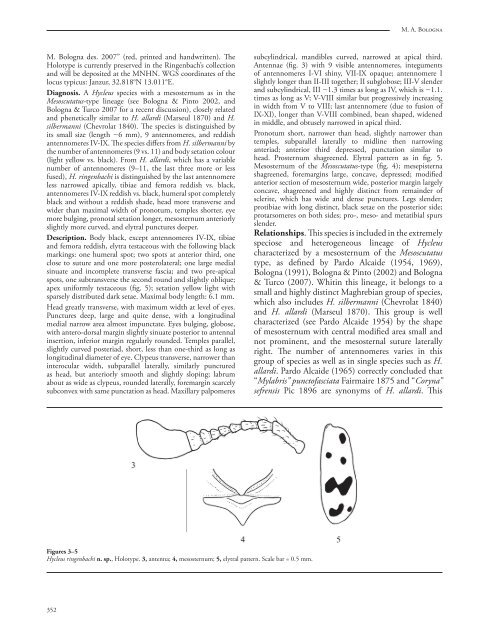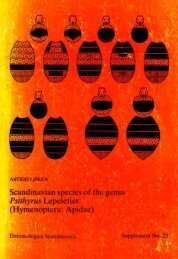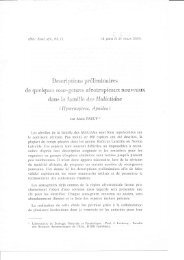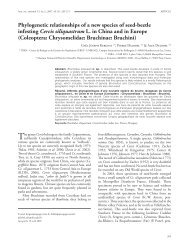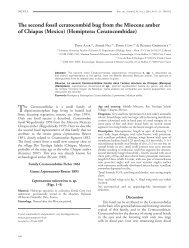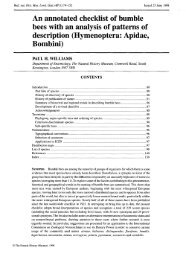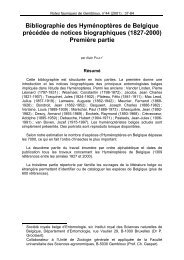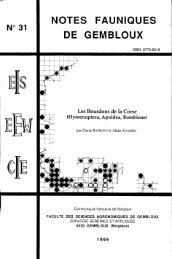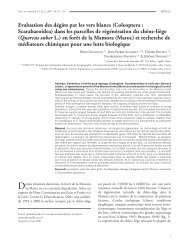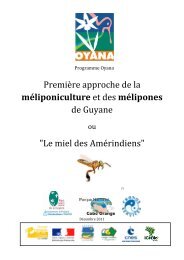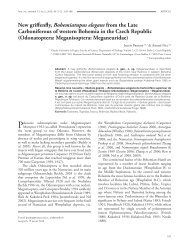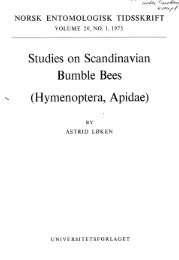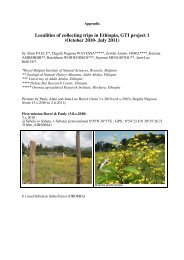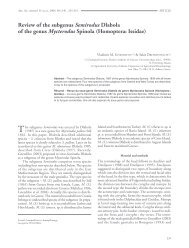Bologna 2009 - Beetles and Rock Art in Libya - Free
Bologna 2009 - Beetles and Rock Art in Libya - Free
Bologna 2009 - Beetles and Rock Art in Libya - Free
You also want an ePaper? Increase the reach of your titles
YUMPU automatically turns print PDFs into web optimized ePapers that Google loves.
M. A. <strong>Bologna</strong><br />
M. <strong>Bologna</strong> des. 2007” (red, pr<strong>in</strong>ted <strong>and</strong> h<strong>and</strong>written). The<br />
Holotype is currently preserved <strong>in</strong> the R<strong>in</strong>genbach’s collection<br />
<strong>and</strong> will be deposited at the MNHN. WGS coord<strong>in</strong>ates of the<br />
locus typicus: Janzur, 32.818°N 13.011°E.<br />
Diagnosis. A Hycleus species with a mesosternum as <strong>in</strong> the<br />
Mesoscutatus-type l<strong>in</strong>eage (see <strong>Bologna</strong> & P<strong>in</strong>to 2002, <strong>and</strong><br />
<strong>Bologna</strong> & Turco 2007 for a recent discussion), closely related<br />
<strong>and</strong> phenetically similar to H. allardi (Marseul 1870) <strong>and</strong> H.<br />
silbermanni (Chevrolat 1840). The species is dist<strong>in</strong>guished by<br />
its small size (length ~6 mm), 9 antennomeres, <strong>and</strong> reddish<br />
antennomeres IV-IX. The species differs from H. silbermanni by<br />
the number of antennomeres (9 vs. 11) <strong>and</strong> body setation colour<br />
(light yellow vs. black). From H. allardi, which has a variable<br />
number of antennomeres (9–11, the last three more or less<br />
fused), H. r<strong>in</strong>genbachi is dist<strong>in</strong>guished by the last antennomere<br />
less narrowed apically, tibiae <strong>and</strong> femora reddish vs. black,<br />
antennomeres IV-IX reddish vs. black, humeral spot completely<br />
black <strong>and</strong> without a reddish shade, head more transverse <strong>and</strong><br />
wider than maximal width of pronotum, temples shorter, eye<br />
more bulg<strong>in</strong>g, pronotal setation longer, mesosternum anteriorly<br />
slightly more curved, <strong>and</strong> elytral punctures deeper.<br />
Description. Body black, except antennomeres IV-IX, tibiae<br />
<strong>and</strong> femora reddish, elytra testaceous with the follow<strong>in</strong>g black<br />
mark<strong>in</strong>gs: one humeral spot; two spots at anterior third, one<br />
close to suture <strong>and</strong> one more posterolateral; one large medial<br />
s<strong>in</strong>uate <strong>and</strong> <strong>in</strong>complete transverse fascia; <strong>and</strong> two pre-apical<br />
spots, one subtransverse the second round <strong>and</strong> slightly oblique;<br />
apex uniformly testaceous (fig. 5); setation yellow light with<br />
sparsely distributed dark setae. Maximal body length: 6.1 mm.<br />
Head greatly transverse, with maximum width at level of eyes.<br />
Punctures deep, large <strong>and</strong> quite dense, with a longitud<strong>in</strong>al<br />
medial narrow area almost impunctate. Eyes bulg<strong>in</strong>g, globose,<br />
with antero-dorsal marg<strong>in</strong> slightly s<strong>in</strong>uate posterior to antennal<br />
<strong>in</strong>sertion, <strong>in</strong>ferior marg<strong>in</strong> regularly rounded. Temples parallel,<br />
slightly curved posteriad, short, less than one-third as long as<br />
longitud<strong>in</strong>al diameter of eye. Clypeus transverse, narrower than<br />
<strong>in</strong>terocular width, subparallel laterally, similarly punctured<br />
as head, but anteriorly smooth <strong>and</strong> slightly slop<strong>in</strong>g; labrum<br />
about as wide as clypeus, rounded laterally, foremarg<strong>in</strong> scarcely<br />
subconvex with same punctation as head. Maxillary palpomeres<br />
subcyl<strong>in</strong>drical, m<strong>and</strong>ibles curved, narrowed at apical third.<br />
Antennae (fig. 3) with 9 visible antennomeres, <strong>in</strong>teguments<br />
of antennomeres I-VI sh<strong>in</strong>y, VII-IX opaque; antennomere I<br />
slightly longer than II-III together; II subglobose; III-V slender<br />
<strong>and</strong> subcyl<strong>in</strong>drical, III ~1.3 times as long as IV, which is ~1.1.<br />
times as long as V; V-VIII similar but progressively <strong>in</strong>creas<strong>in</strong>g<br />
<strong>in</strong> width from V to VIII; last antennomere (due to fusion of<br />
IX-XI), longer than V-VIII comb<strong>in</strong>ed, bean shaped, widened<br />
<strong>in</strong> middle, <strong>and</strong> obtusely narrowed <strong>in</strong> apical third.<br />
Pronotum short, narrower than head, slightly narrower than<br />
temples, subparallel laterally to midl<strong>in</strong>e then narrow<strong>in</strong>g<br />
anteriad; anterior third depressed, punctation similar to<br />
head. Prosternum shagreened. Elytral pattern as <strong>in</strong> fig. 5.<br />
Mesosternum of the Mesoscutatus-type (fig. 4); mesepisterna<br />
shagreened, foremarg<strong>in</strong>s large, concave, depressed; modified<br />
anterior section of mesosternum wide, posterior marg<strong>in</strong> largely<br />
concave, shagreened <strong>and</strong> highly dist<strong>in</strong>ct from rema<strong>in</strong>der of<br />
sclerite, which has wide <strong>and</strong> dense punctures. Legs slender;<br />
protibiae with long dist<strong>in</strong>ct, black setae on the posterior side;<br />
protarsomeres on both sides; pro-, meso- <strong>and</strong> metatibial spurs<br />
slender.<br />
Relationships. This species is <strong>in</strong>cluded <strong>in</strong> the extremely<br />
speciose <strong>and</strong> heterogeneous l<strong>in</strong>eage of Hycleus<br />
characterized by a mesosternum of the Mesoscutatus<br />
type, as def<strong>in</strong>ed by Pardo Alcaide (1954, 1969),<br />
<strong>Bologna</strong> (1991), <strong>Bologna</strong> & P<strong>in</strong>to (2002) <strong>and</strong> <strong>Bologna</strong><br />
& Turco (2007). Whit<strong>in</strong> this l<strong>in</strong>eage, it belongs to a<br />
small <strong>and</strong> highly dist<strong>in</strong>ct Maghrebian group of species,<br />
which also <strong>in</strong>cludes H. silbermanni (Chevrolat 1840)<br />
<strong>and</strong> H. allardi (Marseul 1870). This group is well<br />
characterized (see Pardo Alcaide 1954) by the shape<br />
of mesosternum with central modified area small <strong>and</strong><br />
not prom<strong>in</strong>ent, <strong>and</strong> the mesosternal suture laterally<br />
right. The number of antennomeres varies <strong>in</strong> this<br />
group of species as well as <strong>in</strong> s<strong>in</strong>gle species such as H.<br />
allardi. Pardo Alcaide (1965) correctly concluded that<br />
“Mylabris” punctofasciata Fairmaire 1875 <strong>and</strong> “Coryna”<br />
sefrensis Pic 1896 are synonyms of H. allardi. This<br />
Figures 3–5<br />
Hycleus r<strong>in</strong>genbachi n. sp., Holotype. 3, antenna; 4, mesosternum; 5, elytral pattern. Scale bar = 0.5 mm.<br />
352


